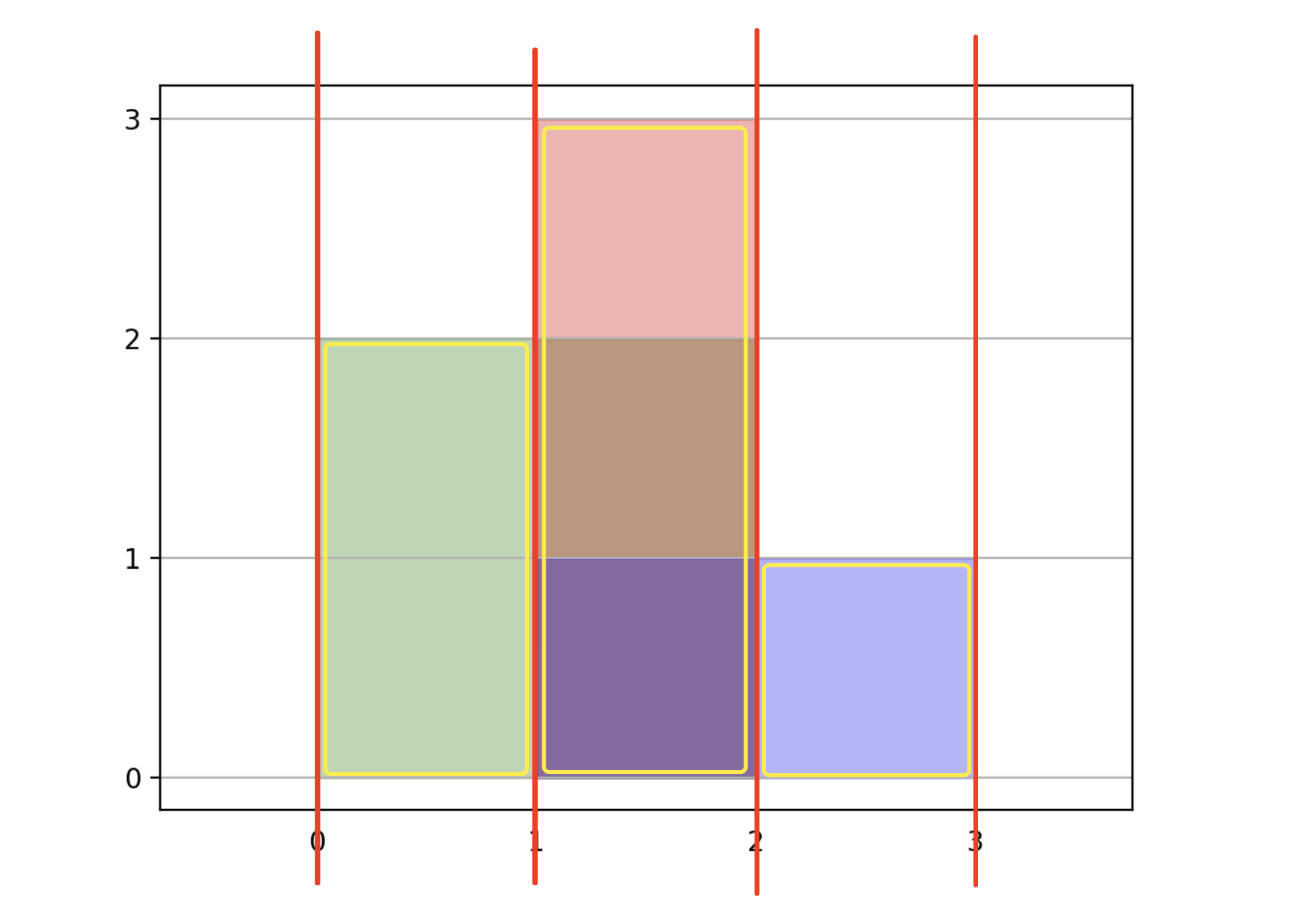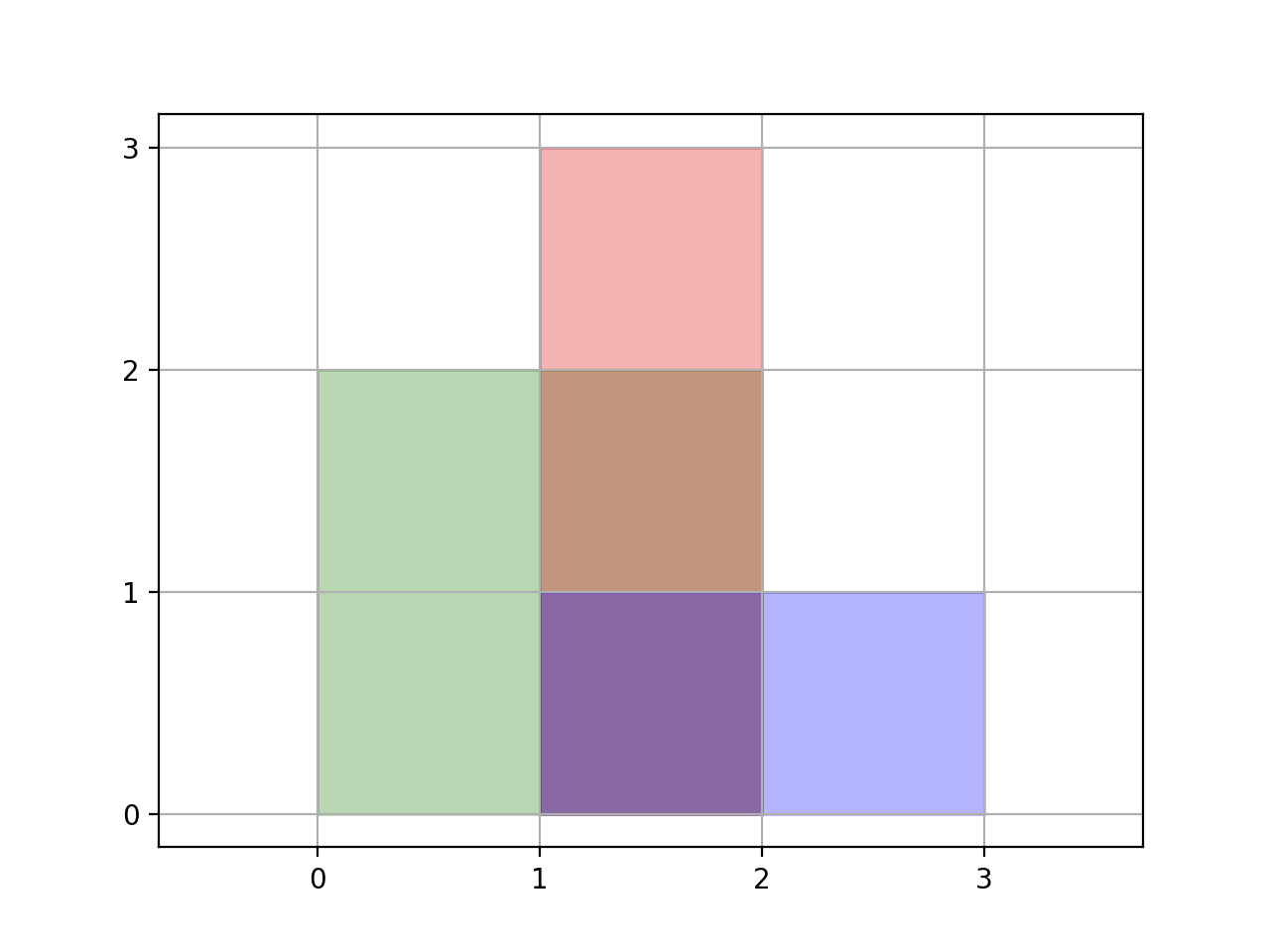扫描线算法
扫描线
扫描线:假设有一条竖直的直线,从平面的最左端扫描到最右端,在扫描的过程中,直线上的一些线段会被给定的矩形覆盖。如果我们将这些覆盖的线段长度进行积分,就可以得到矩形的面积之和。
如图所示,我们可以把整个矩形分成如图各个颜色不同的小矩形,那么这个小矩形的高就是我们扫过的距离,那么剩下了一个变量,那就是矩形的长一直在变化。
我们的线段树就是为了维护矩形的长,我们给每一个矩形的上下边进行标记:
-
下面的边标记为
-
上面的边标记为
每遇到一个矩形时,我们知道了标记为
还要注意这里的线段树指的并不是线段的一个端点,而指的是一个区间,所以我们要计算的是
注意,需要 离散化。
应用
应用1:Leetcode 253. 会议室 II
题目
给你一个会议时间安排的数组 intervals ,每个会议时间都会包括开始和结束的时间 intervals[i] = [starti, endi] ,返回 所需会议室的最小数量 。
示例 1:
输入:intervals = [[0,30],[5,10],[15,20]]
输出:2
解题思路
标准扫描线算法,把每个会议的起始时间标记为
然后,依次遍历所有的节点,统计每个节点的最大会议室数目即可。
代码实现
from typing import List class Node(object): def __init__(self, _time: int, flag: int): self.time = _time self.flag = flag def __lt__(self, other): if self.time == other.time: return self.flag < other.flag else: return self.time < other.time class Solution: def minMeetingRooms(self, intervals: List[List[int]]) -> int: if not intervals: return 0 nodes = list() for interval in intervals: nodes.append(Node(interval[0], 1)) nodes.append(Node(interval[1], -1)) nodes.sort() count = 0 max_count = 0 for node in nodes: if node.flag == 1: count += 1 else: count -= 1 max_count = max(max_count, count) return max_count
类似的题目
应用2:Lintcode 821. Time Intersection
题目
- Time Intersection
Give two users' ordered online time series, and each section records the user's login time point x and offline time point y. Find out the time periods when both users are online at the same time, and output in ascending order.
Example 1:
Input: seqA = [(1,2),(5,100)], seqB = [(1,6)]
Output: [(1,2),(5,6)]
Explanation: In these two time periods (1,2), (5,6), both users are online at the same time.
Example 2:
Input: seqA = [(1,2),(10,15)], seqB = [(3,5),(7,9)]
Output: []
Explanation: There is no time period, both users are online at the same time.
解题思路
扫描线算法,把起点和终点分别记录为
注意,需要从
下降的时候,一定要从
的时候开始记录,否则, 也会被记录进去。
时间复杂度:
代码实现
/** * Definition of Interval: * public classs Interval { * int start, end; * Interval(int start, int end) { * this.start = start; * this.end = end; * } * } */ public class Solution { /** * @param seqA: the list of intervals * @param seqB: the list of intervals * @return: the time periods */ private class Node { public int time; public int flag; public Node(int time, int flag) { this.time = time; this.flag = flag; } } public List<Interval> timeIntersection(List<Interval> seqA, List<Interval> seqB) { List<Node> list = new ArrayList<>(); List<Interval> result = new ArrayList<>(); for(Interval interA: seqA) { list.add(new Node(interA.start, 1)); list.add(new Node(interA.end, -1)); } for(Interval interB: seqB) { list.add(new Node(interB.start, 1)); list.add(new Node(interB.end, -1)); } Collections.sort(list, (a, b) -> (a.time != b.time ? a.time - b.time : a.flag - b.flag)); int count = 0; int start = -1; int end = -1; for(Node node: list) { if(node.flag == 1) { count++; if(count == 2) { start = node.time; } } if(node.flag == -1) { if(count == 2) { end = node.time; result.add(new Interval(start, end)); start = -1; end = -1; } count--; } } return result; } }
应用3:Leetcode 218. 天际线问题
题目
解题思路
将所有的建筑物边界排序,排序规则如下:
-
x坐标小的在前面;
-
x坐标相同时,高度较大的在前面;
我们维护一个大根堆,用于在扫描线移动过程中,获取每个位置的最大高度。
代码实现
import heapq from typing import List class Solution: def getSkyline(self, buildings: List[List[int]]) -> List[List[int]]: result = list() if not buildings: return result boundaries = list() for building in buildings: boundaries.append((building[0], building[2])) boundaries.append((building[1], -building[2])) # 排序规则:x坐标小的在前面,x坐标相同时,高度较大的在前面 boundaries.sort(key=lambda x: (x[0], -x[1])) pre_height = 0 # 这里我们需要维护一个大根堆,使较大的高度在堆顶 pq = list() heapq.heappush(pq, 0) for boundary in boundaries: # 如果遇到左侧的边界,就将其加入优先级队列 if boundary[1] > 0: # 大根堆,所以要取高度的负值 heapq.heappush(pq, -boundary[1]) # 如果遇到右侧的边界,就将右侧的边界出队 else: # 移除该右侧边界 pq.remove(boundary[1]) heapq.heapify(pq) # 获取堆顶的元素的高度,注意取负值 current = -pq[0] if current != pre_height: result.append([boundary[0], current]) pre_height = current return result
应用4:Leetcode 759. 员工空闲时间
题目
给定员工的 schedule 列表,表示每个员工的工作时间。每个员工都有一个非重叠的时间段 Intervals 列表,这些时间段已经排好序。
返回表示 所有 员工的 共同,正数长度的空闲时间 的有限时间段的列表,同样需要排好序。
示例 1:
输入:schedule = [[[1,2],[5,6]],[[1,3]],[[4,10]]]
输出:[[3,4]]
解释:
共有 3 个员工,并且所有共同的
空间时间段是 [-inf, 1], [3, 4], [10, inf]。
我们去除所有包含 inf 的时间段,因为它们不是有限的时间段。
解题思路
算法步骤:
-
先将所有的员工的时间段,离散化,将开始时刻标记为 1,结束时刻标记为 -1,并保存在列表
-
对所有时刻,按照起始时间升序排序,如果时刻相同,则按照标志位降序排序,即如果开始和结束时刻相同,则开始时刻在前面;
-
遍历所有的时刻,并记录当前的状态,遇到一个起始时刻,状态变量
-
当
代码实现
class Solution: def employeeFreeTime(self, schedule: '[[Interval]]') -> '[Interval]': events = list() for employee in schedule: for interval in employee: events.append((interval.start, 1)) events.append((interval.end, -1)) events.sort(key = lambda x : (x[0], -x[1])) results = list() last = None balance = 0 for _time, state in events: if balance == 0 and last: results.append(Interval(last, _time)) if state == 1: balance += 1 else: balance -= 1 last = _time return results
应用5:Leetcode 986. 区间列表的交集
题目
给定两个由一些 闭区间 组成的列表,firstList 和 secondList ,其中 firstList[i] = [starti, endi] 而 secondList[j] = [startj, endj] 。每个区间列表都是成对 不相交 的,并且 已经排序 。
返回这 两个区间列表的交集 。
形式上,闭区间 [a, b](其中 a <= b)表示实数 x 的集合,而 a <= x <= b 。两个闭区间的 交集 是一组实数,要么为空集,要么为闭区间。例如,[1, 3] 和 [2, 4] 的交集为 [2, 3] 。
示例 1:
输入:firstList = [[0,2],[5,10],[13,23],[24,25]], secondList = [[1,5],[8,12],[15,24],[25,26]]
输出:[[1,2],[5,5],[8,10],[15,23],[24,24],[25,25]]
解题思路
算法步骤:
-
先将两个列表的时间段,离散化,将开始时刻标记为 1,结束时刻标记为 -1,并保存在列表
-
对所有时刻,按照起始时间升序排序,如果时刻相同,则按照标志位降序排序,即如果开始和结束时刻相同,则开始时刻在前面;
-
遍历所有的时刻,并记录当前的状态,遇到一个起始时刻,状态变量
-
当
代码实现
class Solution: def intervalIntersection(self, firstList: List[List[int]], secondList: List[List[int]]) -> List[List[int]]: events = list() for interval in firstList: events.append((interval[0], 1)) events.append((interval[1], -1)) for interval in secondList: events.append((interval[0], 1)) events.append((interval[1], -1)) events.sort(key=lambda x: (x[0], -x[1])) result = list() balance = 0 last_balance = 0 last_time = None for event in events: if event[1] == 1: balance += 1 else: balance -= 1 if last_balance == 2 and balance == 1: result.append([last_time, event[0]]) last_balance = balance last_time = event[0] return result
应用6:Leetcode 56. 合并区间
题目
解题思路
方法一:扫描线
算法步骤:
-
先将所有的时间段,离散化,将开始时刻标记为 1,结束时刻标记为 -1,并保存在列表
-
对所有时刻,按照起始时间升序排序,如果时刻相同,则按照标志位降序排序,即如果开始和结束时刻相同,则开始时刻在前面;
-
遍历所有的时刻,并记录当前的状态,遇到一个起始时刻,状态变量
-
对于每一个
-
当
-
当
因此,合并后的区间就是:
-
方法二:排序
算法步骤:
-
首先,我们将列表中的区间按照左端点升序排序。
-
然后我们将第一个区间加入
-
如果当前区间的左端点,在数组
我们可以直接将这个区间加入数组
-
如果当前区间的左端点,在数组
我们需要用当前区间的右端点,更新数组
-
代码实现
class Solution: def merge(self, intervals: List[List[int]]) -> List[List[int]]: events = list() for interval in intervals: events.append((interval[0], 1)) events.append((interval[1], -1)) events.sort(key = lambda x : (x[0], -x[1])) results = list() balance = 0 last_balance = 0 last_time = 0 for event in events: if event[1] == 1: balance += 1 if balance == 1: last_time = event[0] else: balance -= 1 if last_balance == 1 and balance == 0: results.append([last_time, event[0]]) last_balance = balance return results
【方法二】
class Solution: def merge(self, intervals: List[List[int]]) -> List[List[int]]: _intervals = sorted(intervals, key=lambda x: (x[0], -x[1])) # 将第一个区间作为基准 result = [_intervals[0]] for interval in _intervals[1:]: # 区间相交,result[-1][1]表示结果中最后一个区间的终点 if interval[0] <= result[-1][1]: result[-1][1] = max(interval[1], result[-1][1]) # 区间不相交,直接保存当前区间 else: result.append(interval) return result
应用7:Leetcode 850. 矩形面积 II
题目
给你一个轴对齐的二维数组 rectangles 。 对于 rectangle[i] = [x1, y1, x2, y2],其中(x1,y1)是矩形 i 左下角的坐标, (xi1, yi1) 是该矩形 左下角 的坐标, (xi2, yi2) 是该矩形 右上角 的坐标。
计算平面中所有 rectangles 所覆盖的 总面积 。任何被两个或多个矩形覆盖的区域应只计算 一次 。返回 总面积 。因为答案可能太大,返回
示例 1:
输入:rectangles = [[0,0,2,2],[1,0,2,3],[1,0,3,1]]
输出:6
解释:如图所示,三个矩形覆盖了总面积为 6 的区域。
从(1,1)到(2,2),绿色矩形和红色矩形重叠。
从(1,0)到(2,3),三个矩形都重叠。
解题思路
方法一:扫描线
如下图所示,将所有给定的矩形的左右边界对应的 x 端点提取出来并排序,每个端点可看作是一条竖直的线段(红色),问题转换为求解「由多条竖直线段分割开」的多个矩形的面积总和(黄色):

每个相邻线段之间的宽度为单个矩形的「宽度」,可以通过 x 差值直接算得,那么,问题转换为求多个区间内高度的并集,即子矩形的高度,可以使用合并区间的方法求解。
每个区间内的线段总长度就是子矩形的高度,从而就可以得到子矩形的面积了。最后,将所有的区间内的矩形面积相加,即可得到总的覆盖范围了。
方法二:离散化 + 扫描线
思路
如下图所示,每个矩形都有一个左边界和一个右边界,我们假设有一条竖直的直线从左向右扫描:

假设矩形
这里会有一个问题,我们如何维护「覆盖的线段长度」呢?
这里同样可以使用到离散化的技巧,扫描线就是一种离散化的技巧,将大范围的连续的坐标转化成
最外侧的
个部分为射线,不会被矩形覆盖到,并且每一个线段要么完全被覆盖,要么完全不被覆盖。
对于扫描线上的所有线段,我们可以使用一个列表,维护其被覆盖的次数即:
-
当扫描线遇到一个左边界时,我们就将左边界覆盖到的所有线段对应的覆盖次数加
-
当扫描线遇到一个右边界时,我们就将右边界覆盖到的所有线段对应的覆盖次数减
我们可以从左向右扫描,对于每次处理一部分相同的横坐标,再找到这些横坐标对应的矩形的纵坐标,并记录这条线段的覆盖状态。然后,我们累加扫描线上所有被覆盖的线段长度,就可以得到被覆盖矩形的纵向的高度。
最后,对于这部分相同的横坐标,它们被覆盖的面积为水平宽度乘以纵向的高度。用同样的方式,处理每一个横坐标,并累加面积即可得到答案。
算法步骤
-
我们使用列表
注意,由于我们对矩形的上下边界排序了,所以,我们需要引入一个列表
-
同时,使用列表
然后,我们对所有
-
遍历所有矩形的左右边界
那么,当前扫描的区间宽度
-
依次遍历这些相同的横坐标,对于每一个横坐标:
-
通过索引找到它们对应的矩形的纵坐标:
-
遍历
-
-
遍历所有的纵向线段,累加被覆盖的线段,将其作为当前覆盖区域的高度
-
计算当前覆盖区域的面积:
注意,累加的面积时候,每次累加完之后,可以进行一次模运算,这样可以加快计算速度。
-
继续遍历其他的横坐标,并重复上述步骤。
方法三:线段树
方法二中对于数组
-
该节点对应的区间被完整覆盖的次数;
-
该节点对应的区间被覆盖的线段长度。
线段树需要支持:
-
区间增加 1;
-
区间减少 1,并且保证每个被增加 1 的区间在之后一定会减少 1;
-
对于所有非 0 的位置,根据它们的权值进行求和。
由于这种方法严重超纲,因此不在这里详细阐述。
代码实现
【方法一】
from typing import List, Tuple MOD = 1000000007 class Solution: def rectangleArea(self, rectangles: List[List[int]]) -> int: # 记录左右边界 [x1, x2] boundaries = [] for rectangle in rectangles: boundaries.append(rectangle[0]) boundaries.append(rectangle[2]) boundaries.sort() result = 0 for i in range(1, len(boundaries)): x1, x2 = boundaries[i - 1], boundaries[i] # 子矩形的水平宽度 width = x2 - x1 if width == 0: continue # 找到所有覆盖当前子区间的矩形,并记录其上下边界 lines = list() for rectangle in rectangles: if rectangle[0] <= x1 and x2 <= rectangle[2]: lines.append((rectangle[1], rectangle[3])) height = self.count_length(lines) result += height * width return result % MOD @classmethod def count_length(cls, intervals: List[Tuple[int, int]]): """ 计算所有子区间的长度,区间可能重叠 :param intervals: :return: """ intervals.sort() length, start, end = 0, -1, -1 for interval in intervals: # 记录新的区间 if interval[0] > end: # 累加区间长度 length += end - start # 记录新的区间范围 start, end = interval # 合并区间 elif interval[1] > end: end = interval[1] length += end - start return length
【方法二】
from typing import List, Tuple MOD = 1000000007 class Solution: def rectangleArea(self, rectangles: List[List[int]]) -> int: # m 个纵坐标最多可以将平行于Y轴的扫描线分成 m - 1 个区间(去掉两端的射线) vertical_boundaries = set() for rectangle in rectangles: vertical_boundaries.add(rectangle[1]) vertical_boundaries.add(rectangle[3]) vertical_boundaries = sorted(vertical_boundaries) m = len(vertical_boundaries) horizon_boundaries = list() # 记录所有的横坐标 for i, rectangle in enumerate(rectangles): horizon_boundaries.append((rectangle[0], i, 1)) horizon_boundaries.append((rectangle[2], i, -1)) # 将矩形的所有左右边界按从小到大的顺序排序 horizon_boundaries.sort() # 记录Y轴上每一个线段的状态 cover_times = [0] * (m - 1) result = 0 i = 0 # 扫描线水平从左向右扫描所有的X坐标 while i < len(horizon_boundaries): j = i + 1 # 找到第一个不相等的横坐标 while j < len(horizon_boundaries) and horizon_boundaries[i][0] == horizon_boundaries[j][0]: j += 1 if j == len(horizon_boundaries): break # 遍历 [i, j - 1] 范围内的 x 坐标,更新它们对应的纵向线段的覆盖状态 for k in range(i, j): _, index, diff = horizon_boundaries[k] # 找到这些 x 坐标所对应的上下边界的纵坐标 y1, y2 y1, y2 = rectangles[index][1], rectangles[index][3] # 遍历所有的纵向线段,线段有两种状态:线段被矩形覆盖;不在矩形覆盖范围内。 for p in range(m - 1): # 如果该线段在 [y1, y2] 覆盖范围内,就更新其状态 if y1 <= vertical_boundaries[p] and vertical_boundaries[p + 1] <= y2: cover_times[p] += diff # 求扫描线上被矩形覆盖的线段之和,也就是高度 height = 0 # 遍历所有的纵向线段 for p in range(m - 1): # 如果线段它被矩形覆盖,其高度一定是两个相邻线段的差值 if cover_times[p] > 0: height += (vertical_boundaries[p + 1] - vertical_boundaries[p]) # 计算扫描线经过范围内被覆盖的面积 result += height * (horizon_boundaries[j][0] - horizon_boundaries[i][0]) result %= MOD i = j return result
【方法三】
import bisect from typing import List class Segtree: def __init__(self): self.cover = 0 self.length = 0 self.max_length = 0 @classmethod def init(cls, tree: List["Segtree"], idx: int, l: int, r: int, hbound: List[int]) -> None: tree[idx].cover = tree[idx].length = 0 if l == r: tree[idx].max_length = hbound[l] - hbound[l - 1] return mid = (l + r) // 2 cls.init(tree, idx * 2, l, mid, hbound) cls.init(tree, idx * 2 + 1, mid + 1, r, hbound) tree[idx].max_length = tree[idx * 2].max_length + tree[idx * 2 + 1].max_length @classmethod def update(cls, tree: List["Segtree"], index: int, l: int, r: int, ul: int, ur: int, diff: int) -> None: if l > ur or r < ul: return if ul <= l and r <= ur: tree[index].cover += diff cls.pushup(tree, index, l, r) return mid = (l + r) // 2 cls.update(tree, index * 2, l, mid, ul, ur, diff) cls.update(tree, index * 2 + 1, mid + 1, r, ul, ur, diff) cls.pushup(tree, index, l, r) @classmethod def pushup(cls, tree: List["Segtree"], idx: int, l: int, r: int) -> None: if tree[idx].cover > 0: tree[idx].length = tree[idx].max_length elif l == r: tree[idx].length = 0 else: tree[idx].length = tree[idx * 2].length + tree[idx * 2 + 1].length class Solution: def rectangleArea(self, rectangles: List[List[int]]) -> int: hbound = set() for rectangle in rectangles: # 下边界 hbound.add(rectangle[1]) # 上边界 hbound.add(rectangle[3]) hbound = sorted(hbound) m = len(hbound) # 线段树有 m-1 个叶子节点,对应着 m-1 个会被完整覆盖的线段,需要开辟 ~4m 大小的空间 tree = [Segtree() for _ in range(m * 4 + 1)] Segtree.init(tree, 1, 1, m - 1, hbound) sweep = list() for i, rectangle in enumerate(rectangles): # 左边界 sweep.append((rectangle[0], i, 1)) # 右边界 sweep.append((rectangle[2], i, -1)) sweep.sort() result = 0 i = 0 while i < len(sweep): j = i while j + 1 < len(sweep) and sweep[i][0] == sweep[j + 1][0]: j += 1 if j + 1 == len(sweep): break # 一次性地处理掉一批横坐标相同的左右边界 for k in range(i, j + 1): _, index, diff = sweep[k] # 使用二分查找得到完整覆盖的线段的编号范围 left = bisect.bisect_left(hbound, rectangles[index][1]) + 1 right = bisect.bisect_left(hbound, rectangles[index][3]) Segtree.update(tree, 1, 1, m - 1, left, right, diff) result += tree[1].length * (sweep[j + 1][0] - sweep[j][0]) i = j + 1 return result % (10 ** 9 + 7)
参考:
本文作者:LARRY1024
本文链接:https://www.cnblogs.com/larry1024/p/17683177.html
版权声明:本作品采用知识共享署名-非商业性使用-禁止演绎 2.5 中国大陆许可协议进行许可。






【推荐】国内首个AI IDE,深度理解中文开发场景,立即下载体验Trae
【推荐】编程新体验,更懂你的AI,立即体验豆包MarsCode编程助手
【推荐】抖音旗下AI助手豆包,你的智能百科全书,全免费不限次数
【推荐】轻量又高性能的 SSH 工具 IShell:AI 加持,快人一步